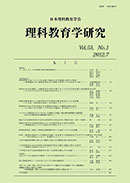Volume 57, Issue 4
SPECIAL ISSUE DESIGNING SCIENCE LEARNING ENVIRONMENTS
Displaying 1-9 of 9 articles from this issue
- |<
- <
- 1
- >
- >|
Preface
-
2017 Volume 57 Issue 4 Pages 323-324
Published: March 18, 2017
Released on J-STAGE: July 08, 2017
Download PDF (547K)
Original Papers
-
2017 Volume 57 Issue 4 Pages 325-336
Published: March 18, 2017
Released on J-STAGE: July 08, 2017
Download PDF (1128K) -
2017 Volume 57 Issue 4 Pages 337-349
Published: March 18, 2017
Released on J-STAGE: July 08, 2017
Download PDF (4080K) -
2017 Volume 57 Issue 4 Pages 351-358
Published: March 18, 2017
Released on J-STAGE: July 08, 2017
Download PDF (827K) -
2017 Volume 57 Issue 4 Pages 359-368
Published: March 18, 2017
Released on J-STAGE: July 08, 2017
Download PDF (2409K) -
2017 Volume 57 Issue 4 Pages 369-385
Published: March 18, 2017
Released on J-STAGE: July 08, 2017
Download PDF (844K) -
2017 Volume 57 Issue 4 Pages 387-401
Published: March 18, 2017
Released on J-STAGE: July 08, 2017
Download PDF (1875K) -
2017 Volume 57 Issue 4 Pages 403-421
Published: March 18, 2017
Released on J-STAGE: July 08, 2017
Download PDF (1015K) -
2017 Volume 57 Issue 4 Pages 423-434
Published: March 18, 2017
Released on J-STAGE: July 08, 2017
Download PDF (991K)
- |<
- <
- 1
- >
- >|
